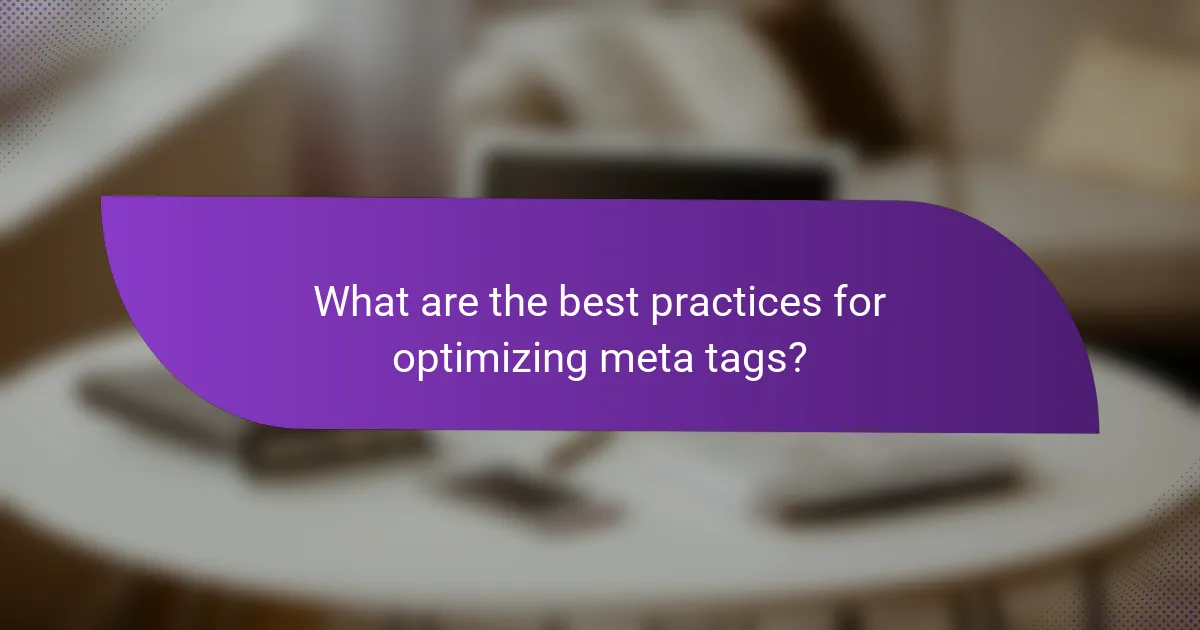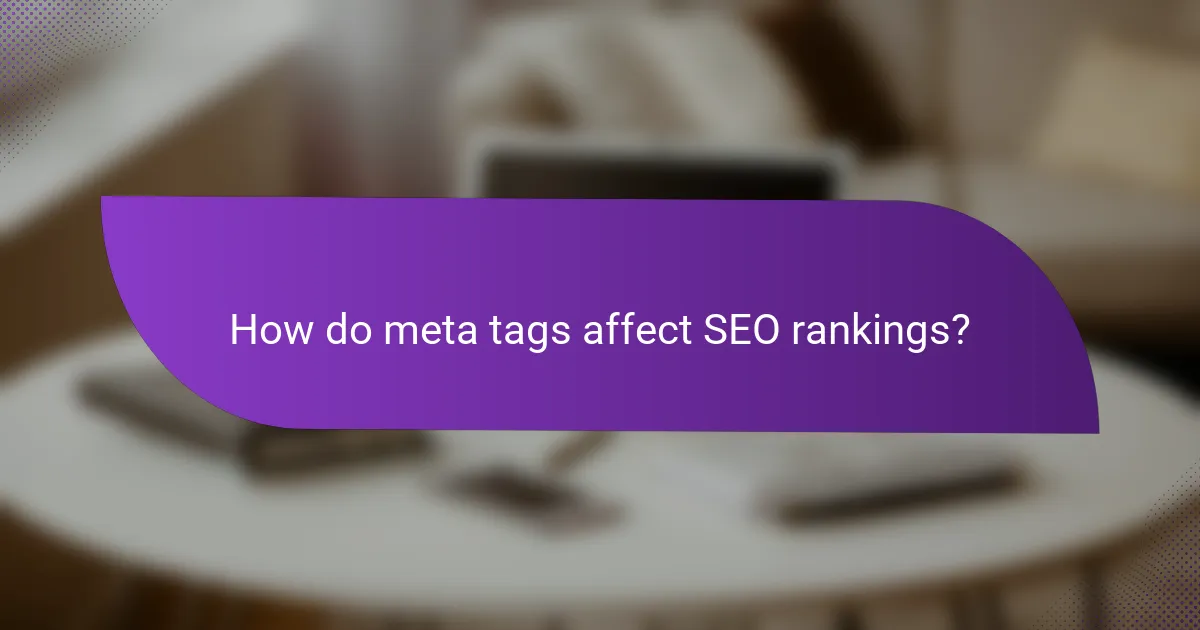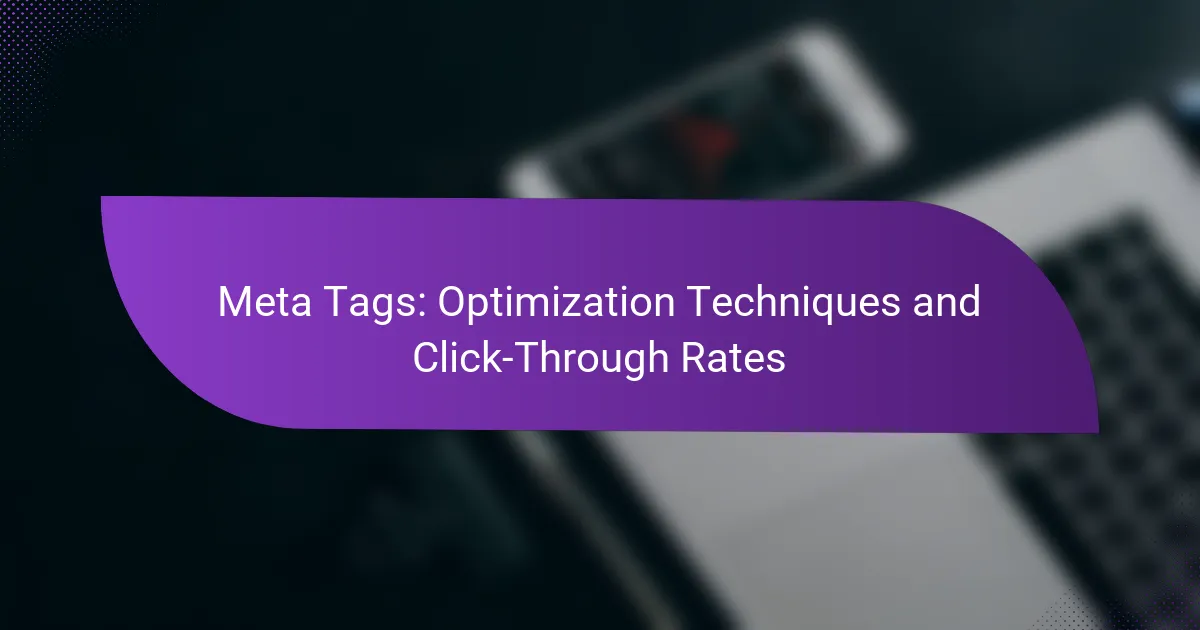Meta tags play a vital role in enhancing click-through rates (CTR) by delivering concise and relevant information that attracts users to search results. By effectively optimizing these tags, websites can boost their visibility in search engine results, driving increased traffic and engagement.

How can meta tags improve click-through rates?
Meta tags can significantly enhance click-through rates (CTR) by providing concise and relevant information that encourages users to click on a search result. By optimizing meta tags, websites can improve their visibility and relevance in search engine results, ultimately driving more traffic.
Enhanced visibility in search results
Meta tags, particularly the title and description tags, play a crucial role in how search engines display results. A well-crafted title tag can make a webpage stand out in search results, increasing the likelihood that users will notice and click on it. Aim for titles that are clear, descriptive, and include relevant keywords.
For example, a title like “Affordable SEO Services for Small Businesses” is likely to attract more clicks than a generic title such as “SEO Services.” Keeping title lengths between 50-60 characters can help ensure they are fully displayed in search results.
Improved relevance to user queries
Meta tags help align your content with user intent by incorporating keywords that match common search queries. When users see a title and description that directly address their needs, they are more inclined to click. Conduct keyword research to identify terms that potential visitors are using and integrate them naturally into your meta tags.
Using tools like Google Keyword Planner can help identify high-volume keywords. Ensure that your meta descriptions are around 150-160 characters to provide enough context without being truncated in search results.
Increased engagement through compelling descriptions
A compelling meta description can entice users to click by summarizing the value of your content. Use action-oriented language and highlight unique selling points to create urgency or interest. Phrases like “Discover,” “Learn how,” or “Get started today” can motivate users to take action.
Avoid generic descriptions; instead, tailor them to reflect the specific content of the page. Testing different descriptions can reveal which versions yield the highest CTR, so consider A/B testing your meta tags to find the most effective combinations.

What are the best practices for optimizing meta tags?
Optimizing meta tags is crucial for improving search engine visibility and click-through rates. Best practices include using targeted keywords, crafting unique meta descriptions, and adhering to character limits to ensure your tags are effective and engaging.
Use of targeted keywords
Incorporating targeted keywords into your meta tags helps search engines understand the content of your page. Focus on primary keywords that are relevant to your content and likely to be used by your audience in search queries.
Place the main keyword towards the beginning of the meta title and description for better visibility. For example, if your page is about “organic gardening tips,” ensure that phrase appears early in your tags.
Crafting unique meta descriptions
Each page should have a unique meta description that accurately reflects its content. A well-crafted description not only improves SEO but also entices users to click through to your site.
Keep the description engaging and informative, ideally between 150-160 characters. For instance, a description like “Discover essential tips for successful organic gardening, from soil preparation to pest management” can attract more clicks.
Adhering to character limits
Meta tags have specific character limits that should be respected to avoid truncation in search results. Typically, meta titles should be around 50-60 characters, while meta descriptions should stay within 150-160 characters.
Use tools or online character counters to ensure your tags fit within these limits. This practice helps maintain the integrity of your message and ensures users see the full context when browsing search results.

Which tools can assist in meta tag optimization?
Several tools can enhance meta tag optimization, helping to improve search engine visibility and click-through rates. Utilizing these tools can streamline the process of keyword analysis, performance tracking, and content optimization.
SEMrush for keyword analysis
SEMrush is a powerful tool for conducting keyword analysis, which is essential for optimizing meta tags. It allows users to identify high-traffic keywords and assess their competition, helping to choose the most effective terms for inclusion in meta titles and descriptions.
When using SEMrush, focus on the Keyword Magic Tool to generate relevant keyword ideas and the Keyword Difficulty metric to gauge how competitive a keyword is. Aim for a balance between high search volume and manageable competition to maximize your chances of ranking well.
Yoast SEO for WordPress
Yoast SEO is a popular plugin for WordPress that simplifies the optimization of meta tags directly within your content management system. It provides real-time feedback on your meta titles and descriptions, ensuring they are not only keyword-rich but also engaging for users.
Utilize Yoast’s readability analysis and snippet preview features to refine your meta tags. Keep meta titles around 50-60 characters and descriptions between 150-160 characters to ensure they display correctly in search results.
Google Search Console for performance tracking
Google Search Console is essential for tracking the performance of your meta tags after implementation. It provides insights into how your pages are performing in search results, including click-through rates and average positions for specific queries.
Regularly review the Performance report to identify which meta tags are driving traffic and which may need adjustment. Pay attention to impressions versus clicks to determine if your titles and descriptions are compelling enough to encourage user engagement.

What are common mistakes in meta tag optimization?
Common mistakes in meta tag optimization include using duplicate tags, neglecting mobile users, and overstuffing with keywords. These errors can significantly reduce click-through rates and negatively impact search engine rankings.
Duplicate meta tags across pages
Using duplicate meta tags across multiple pages can confuse search engines and dilute the relevance of your content. Each page should have unique meta tags that accurately reflect its specific content to improve visibility and ranking.
To avoid duplication, create a checklist for each page, ensuring that the title and description are tailored to the unique aspects of that page. Aim for concise titles under 60 characters and descriptions around 150-160 characters.
Ignoring mobile optimization
Failing to optimize meta tags for mobile users can lead to poor user experience and lower click-through rates. With a significant portion of web traffic coming from mobile devices, it’s essential to ensure that your meta tags are mobile-friendly.
Use responsive design principles and test how your meta tags appear on various screen sizes. Keep titles and descriptions clear and concise, as mobile users often skim content quickly.
Overstuffing keywords
Overstuffing keywords in meta tags can lead to penalties from search engines and deter potential visitors. Instead of cramming multiple keywords, focus on a few relevant terms that accurately describe the page’s content.
Use natural language in your meta tags and prioritize user intent. A good rule of thumb is to include your primary keyword once in the title and once in the description, ensuring that they read smoothly and make sense to users.

How do meta tags affect SEO rankings?
Meta tags significantly influence SEO rankings by providing search engines with essential information about a webpage’s content. They help search engines understand the relevance of a page to specific queries, which can ultimately affect its visibility in search results.
Influence on click-through rates
Meta tags, particularly the title and description tags, play a crucial role in determining click-through rates (CTR). A well-crafted title that includes relevant keywords can attract more clicks, while a compelling meta description can entice users to choose your link over others. Aim for a title length of around 50-60 characters and a description of 150-160 characters for optimal visibility.
For example, a title like “Affordable SEO Services for Small Businesses” is likely to perform better than a generic “SEO Services.” This specificity can lead to higher CTRs, which indirectly boosts SEO rankings.
Impact on user engagement metrics
User engagement metrics, such as bounce rate and time on page, can be influenced by meta tags. If the title and description accurately reflect the content, users are more likely to stay on the page, reducing bounce rates. Conversely, misleading tags can lead to higher bounce rates, negatively impacting SEO.
To enhance engagement, ensure that your meta tags align with user intent. For instance, if your page offers a guide on “How to Optimize Meta Tags,” your tags should clearly indicate this focus to attract the right audience.
Role in search engine algorithms
Search engine algorithms consider meta tags as part of their ranking criteria, although their weight has evolved over time. While meta tags alone won’t guarantee high rankings, they contribute to the overall context that search engines use to evaluate a page’s relevance and authority.
It’s essential to keep meta tags updated and relevant, as search engines favor fresh content. Regularly reviewing and optimizing your meta tags can help maintain or improve your rankings in search results.

What metrics should be tracked for meta tag performance?
To effectively evaluate meta tag performance, focus on metrics such as click-through rate (CTR), impressions, and average position in search results. These metrics provide insights into how well your meta tags are attracting users and driving traffic to your site.
Click-through rate (CTR)
Click-through rate (CTR) measures the percentage of users who click on your link after seeing it in search results. A higher CTR indicates that your meta tags are compelling and relevant to users’ search queries.
To optimize CTR, consider using action-oriented language and including relevant keywords in your title and description. For example, a title like “Top 10 Budget Travel Tips” may attract more clicks than a generic title.
Aim for a CTR in the low to mid-teens as a benchmark, but remember that industry standards can vary. Regularly monitor your CTR and adjust your meta tags based on performance data to improve user engagement.
